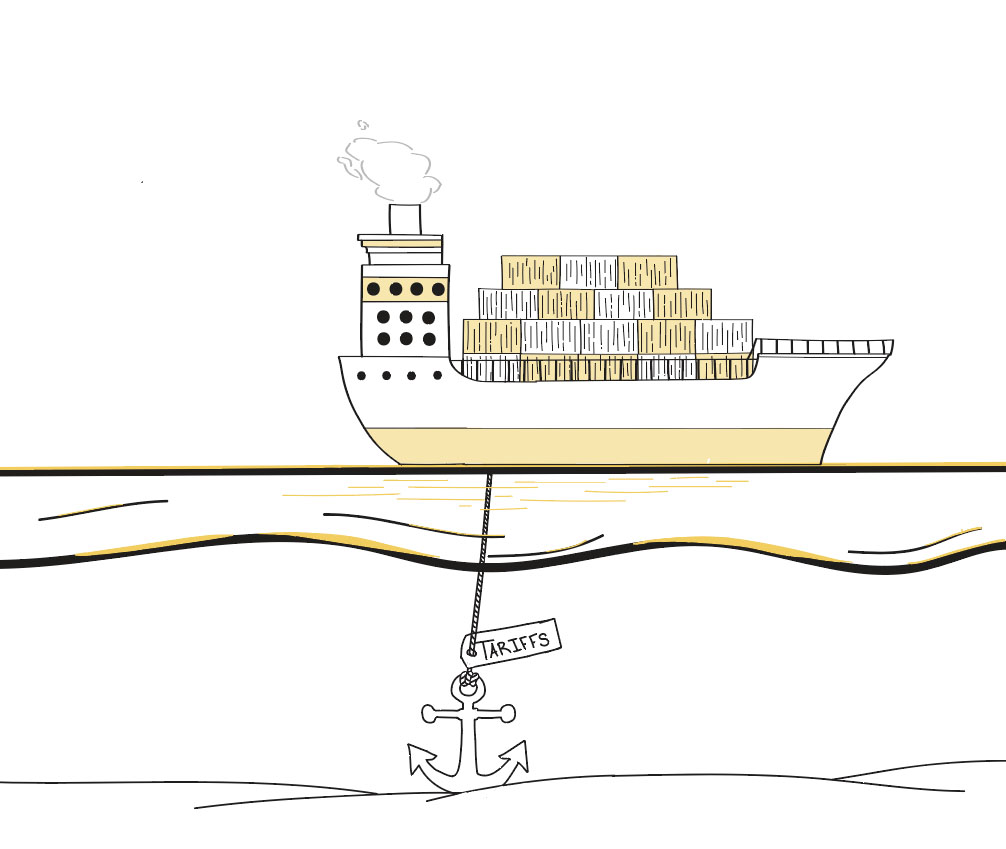Each election cycle, it feels like the entire country goes back to government class: The press explains how primary elections work, what specific policies actually do, and why the US has the electoral college. Question and answer articles are published in what feels like every newspaper about these topics. but during the 2024 election, an unusual topic became a leading issue of discussion: tariffs. Thanks to President Donald Trump’s long-touted campaign promise of tariffs on imported goods, Google searches regarding tariffs have been up 1650% since the election.
Opinions about these tariffs vary significantly – some think that they will be the country’s saving grace, while others believe that they will send the nation spiraling. It’s important for everyone to understand the reality of tariffs before fully forming an opinion.
What is a tariff?
In simplest terms, a tariff is “a tax levied on an imported good,” according to NHS economics teacher Chris Schrank. Most purchases and transactions in the United States are subject to taxes, and we are used to this – we know that what we see on the price tag is not what we actually pay at the register. However, only products that are coming from outside the US–imported goods–are subject to this specific tax. Additionally, tariffs bring on an additional, higher rate for these goods. When discussing a 10% tariff, this is 10% of the cost of the good on top of the cost of the product itself.
Who controls tariffs?
Each country chooses the tariffs it would like to enact.
“If the American government decides to levy a tariff on a particular item, then that item will face an extra cost as it is brought into the USA,” Schrank said. But then…
Who pays for tariffs?
“A misconception is that the country that sent the goods is the one that pays the tax. That is not what occurs,” Schrank said. “Instead, it is the one purchasing the goods, usually a business or corporation, that pays the tariff, and when that item gets ready to cross the border, they are the ones that pay the extra cost to Customs and Border Patrol.”
To be clear, it is not the United States government that pays for tariffs – in fact, the government generates revenue from tariffs, because they are a form of tax. However, when companies have to pay these tariffs for their goods to enter the country, this increases the cost of production for these items. Because the production cost is higher, the price that these products are sold for is often raised as well, leading to higher prices for consumers.
Now, a stronger understanding of tariffs makes it obvious that those recently enacted will not benefit an already struggling US economy. According to the US Bureau of Labor Statistics’ Consumer Price Index, inflation was still at 3% in January. Americans are feeling the effects of inflation too, as seen through a Pew Research Center poll from September which had 81% of voters reporting that the economy was their top issue for the election. The same poll also reported that Trump led Democratic nominee Kamala Harris by 10 points when it came to confidence in his economic policy. Many voters chose Trump because of their hopes for a strong economy under his administration, thinking he would bring inflation and prices down. However, his proposed tariffs go exactly against this belief.
Think about who really pays for tariffs. Officially, it is the companies that are importing goods into the United States. However, because production prices for these products are then increased, this cost is often passed on to consumers, and eventually it leads to an increase in prices for consumers. In other words: inflation. When this is added on top of an already inflation-riddled economy, it could spell disaster – or even recession, a word economists have been panicking about since the economic downturn of the COVID-19 pandemic.
What will these price increases really look like, though? Trump’s recently enacted, and then quickly paused, near-universal tariff is only 10% (for most countries). It would be easy to assume that an amount so small would not make its way to consumers, but don’t be so sure.
Estimates for the true price of tariffs vary, and for good reason: economies change quickly and in reality, it is impossible to know exactly how much tariffs will cost each American. However, ever since Trump first announced his tariff plan on the campaign trail, economists have been making predictions.
This includes an April 2 Yale Budget Lab report cited by news organizations across the political spectrum that forecasted the average American family will pay $3,800 more per year. Broken down month by month, that is roughly equal to what the average family pays for utilities.
However, these price hikes will not be felt in the same ways across the board. An April CBS News article predicted even higher increases on everyday products like electronics, cars, and coffee, with a BBC article from the same day adding gasoline to the list. These increases come right as college-bound seniors are looking for a new laptop to bring to school, freshly-licensed sixteen year olds are looking into getting their first cars, iced-coffee addictions are coming back in season, and student drivers attempt to keep the “E” on their car’s dashboard from lighting up.
These tariffs have the potential to impact not just consumers nationwide, but also people across the world. Stock markets have faced incredible, hour-by-hour fluctuations due to how quickly the story around tariffs is changing. The Wall Street Journal reported on April 4 that major stock indexes had dropped by 6% in response to the April second tariffs. Then, on April 9, when the Trump administration announced a pause on most of the April 2 tariffs, Reuters reported that the markets made massive gains in just hours, with the S&P 500 index surging by 9.5%. However, by the end of the next day, anxieties around the unpredictability of these tariffs had caused another round of sell-offs, leading to further losses. While impacts on the stock market may seem abstract, these can have real consequences for retirement accounts as well as teens’ savings accounts, right as they may be dipping into them to pay for college.
Globally, enacting tariffs like these can lead to trade wars, and it seems as though that will likely be the future. China, one of America’s largest trading partners, announced an 84% retaliatory tariff on the US after the US levied a 125% tariff on the country on April 9, and the European Union has been discussing retaliatory tariffs as well.
“That means the prices of American goods in foreign countries will go up, and those consumers will be less likely to buy American products,” Schrank said. “That hurts overall revenues for American companies, as they attempt to sell in foreign markets.”
It is important to understand the rationale for why these tariffs are going into effect, and the reasons are valid. The executive order that enacted the April 2 tariffs specifically cites protecting American workers as a reason for the tariff. This is, of course, a valid and noble pursuit. The US has been losing manufacturing operations to other countries for decades, and bringing those operations back would have a positive effect on the domestic economy. However, enacting tariffs in this way will not make the impact that the administration is hoping for.
“If a company were to invest in manufacturing here to avoid the tariff, it will likely be years before we can really see that impact,” Schrank said. “The company has to build a factory, hire workers, and obtain the resources, all of which takes time.”
So, as the country waits with bated breath to see what tariffs will actually accomplish, for better or for worse, there is only so much for a consumer, or a high schooler, to do.
Keeping up to date on the news to know where tariffs with different countries stand will be the best way to understand each moment, as the situation can change drastically within just a few hours. This can help anticipate and prepare for feeling the effects of these tariffs, when it comes to higher prices. Looking for local and American-made products will help save money as tariffs on foreign manufacturers will likely cause price hikes, so it pays to be an informed consumer.
While tariffs and their effects may cause some to be fearful, a stronger understanding of tariffs as a whole will help to bring things into perspective. Though the future is unknown and looking somewhat bleak, education is the best shield. By knowing what is going on and how it can affect each individual, these effects can be prepared for and endured.









